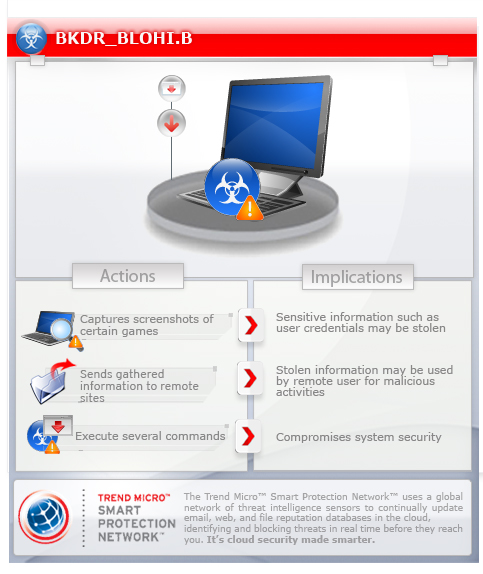BKDR_BLOHI.B
Backdoor:Win32/Blohi.B (Microsoft), W32/Writos.CW!tr (Fortinet), Mal/VBCheMan-C (Sophos), Trojan.Win32.Generic!BT (Sunbelt)
Windows 2000, Windows Server 2003, Windows XP (32-bit, 64-bit), Windows Vista (32-bit, 64-bit), Windows 7 (32-bit, 64-bit)


Threat Type: Backdoor
Destructiveness: No
Encrypted: No
In the wild: Yes
OVERVIEW
Downloaded from the Internet, Dropped by other malware
This backdoor monitors and captures screenshots of specific Korean games. It is also capable of displaying fake blue screen of death screens.
To get a one-glance comprehensive view of the behavior of this Backdoor, refer to the Threat Diagram shown below.

This backdoor arrives on a system as a file dropped by other malware or as a file downloaded unknowingly by users when visiting malicious sites.
It executes commands from a remote malicious user, effectively compromising the affected system.
It retrieves specific information from the affected system. It sends the information it gathers to remote sites.
However, as of this writing, the said sites are inaccessible.
TECHNICAL DETAILS
459,991 bytes
EXE
Yes
03 Jan 2013
Connects to URLs/IPs, Collects system information, Logs keystrokes, Downloads files, Compromises system security
Arrival Details
This backdoor arrives on a system as a file dropped by other malware or as a file downloaded unknowingly by users when visiting malicious sites.
Autostart Technique
This backdoor adds the following registry entries to enable its automatic execution at every system startup:
HKEY_LOCAL_MACHINE\Software\Microsoft\
Windows\CurrentVersion\Run
{random string} = "{Malware Path and File Name}"
HKEY_LOCAL_MACHINE\Software\Microsoft\
Windows\CurrentVersion\Policies\
Explorer\Run
{random string} = "{Malware Path and File Name}"
Other System Modifications
This backdoor adds the following registry entries:
HKEY_LOCAL_MACHINE\System\CurrentControlSet\
Services\SharedAccess\Parameters\
FirewallPolicy\StandardProfile
DoNotAllowExceptions = "0"
It creates the following registry entry(ies) to bypass Windows Firewall:
HKEY_LOCAL_MACHINE\System\CurrentControlSet\
Services\SharedAccess\Parameters\
FirewallPolicy\StandardProfile\AuthorizedApplications\
List
{Malware Path and File Name} = "{Malware Path and File Name}:*:Enabled:Microsoft (R) Internetal IExplore"
Backdoor Routine
This backdoor executes the following commands from a remote malicious user:
- Download and execute arbitrary files
- Display Fake BSOD
- Capture screenshots of certain games
- Log Keystrokes
- Disable Mouse
- Shutdown computer
Download Routine
This backdoor accesses the following websites to download files:
- http://{BLOCKED}update.{BLOCKED}y.com/attachment/cfile7.uf@197407484F516F1829F7A5.ocx
- http://{BLOCKED}7.uf.{BLOCKED}y.com/attach/197407484F516F1829F7A5
Information Theft
This backdoor retrieves the following information from the affected system:
- Installed AntiVirus Products (CompanyName, DisplayName, Version Number)
- System Information (Computer Name, Processor Information, Physical Memory)
It sends the information it gathers to remote sites.
Other Details
This backdoor connects to the following URL(s) to check for an Internet connection:
- http://{BLOCKED}g.{BLOCKED}r.com/PostView.nhn?blogId=windowupdate&logNo={number}&parentCategoryNo=1&viewDate=¤tPage=1&listtype=0&userTopListOpen=false&userTopListCount=5&userTopListManageOpen=false&userTopListCurrentPage=undefined
However, as of this writing, the said sites are inaccessible.
NOTES:
It monitors the following games:
- Baduki
- DuelPoker
- Highlow2
- HOOLA3
- LASPOKER
- Poker7
It checks if it is running under a virtual environment by querying the following registry key:
- HKEY_LOCAL_MACHINE\System\CurrentControlSet\Services\Disk\Enum
It checks for the presence of the following strings on the aforementioned registry:
- VBOX
- Virtual
- VMware
It queries the following registry key to get the processor information:
- HKEY_LOCAL_MACHINE\HARDWARE\DESCRIPTION\System\CentralProcessor\0\~MHz
SOLUTION
9.300
9.634.03
03 Jan 2013
9.635.00
04 Jan 2013
Step 1
Before doing any scans, Windows XP, Windows Vista, and Windows 7 users must disable System Restore to allow full scanning of their computers.
Step 2
Scan your computer with your Trend Micro product and note files detected as BKDR_BLOHI.B
Step 3
Restart in Safe Mode
Step 4
Delete this registry value
Important: Editing the Windows Registry incorrectly can lead to irreversible system malfunction. Please do this step only if you know how or you can ask assistance from your system administrator. Else, check this Microsoft article first before modifying your computer's registry.
- In HKEY_LOCAL_MACHINE\Software\Microsoft\Windows\CurrentVersion\Policies\Explorer\Run
- {random string} = "{Malware Path and File Name}"
- {random string} = "{Malware Path and File Name}"
- In HKEY_LOCAL_MACHINE\Software\Microsoft\Windows\CurrentVersion\Run
- {random string} = "{Malware Path and File Name}"
- {random string} = "{Malware Path and File Name}"
- In HKEY_LOCAL_MACHINE\System\CurrentControlSet\Services\SharedAccess\Parameters\FirewallPolicy\StandardProfile\AuthorizedApplications\List
- {Malware Path and File Name} = "{Malware Path and File Name}:*:Enabled:Microsoft (R) Internetal IExplore"
- {Malware Path and File Name} = "{Malware Path and File Name}:*:Enabled:Microsoft (R) Internetal IExplore"
- In HKEY_LOCAL_MACHINE\System\CurrentControlSet\Services\SharedAccess\Parameters\FirewallPolicy\StandardProfile
- DoNotAllowExceptions = "0"
- DoNotAllowExceptions = "0"
Step 5
Search and delete the file detected as BKDR_BLOHI.B
Step 6
Restart in normal mode and scan your computer with your Trend Micro product for files detected as BKDR_BLOHI.B. If the detected files have already been cleaned, deleted, or quarantined by your Trend Micro product, no further step is required. You may opt to simply delete the quarantined files. Please check this Knowledge Base page for more information.
Step 7
Scan your computer with your Trend Micro product to delete files detected as BKDR_BLOHI.B. If the detected files have already been cleaned, deleted, or quarantined by your Trend Micro product, no further step is required. You may opt to simply delete the quarantined files. Please check this Knowledge Base page for more information.
Did this description help? Tell us how we did.

